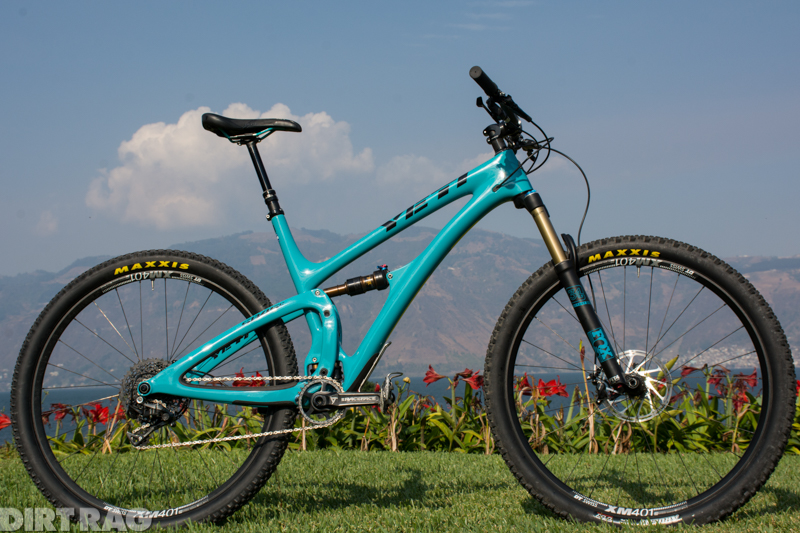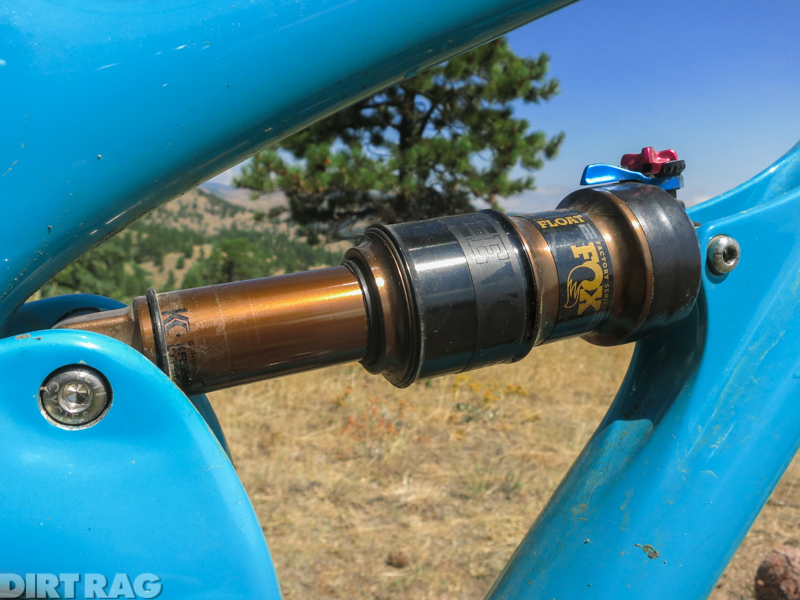Review: Yeti SB4.5c
Originally posted on April 13, 2017 at 1:53 amWords and photos by Zach White
Age:42 x Height: 6’2″ x Weight: 200 lbs. x Inseam: 32”
“Hey man, sweet bike!” As a bike whore, er, “product reviewer,” I get an interesting perspective on brands and their reputation. There are times when I’ll ride a completely dialed and worthy bike for months on trails shotgunned throughout North America, and not hear a peep from other trail users about the loaner. Then, there are brands like Yeti where it’s more common than not to have someone at the trailhead say how cool “my” bike is, usually at the first glimpse of the telltale turquoise blue being pulled out of the van. Funny thing is, with a long habit of asking people who throw bold claims out to strangers where their opinions come from, the usual reply has nothing to do with personal experience and everything to do with unfounded perception. So, is the SB4.5c all Yeti hype, or is there some legitimacy to random dudes’ claims at the trailhead?

A new 29er model as of early 2016, the SB4.5c is on the lighter and racier end of the company’s Switch Infinity suspension platform offerings, with a mere 4.5 inches of namesake rear wheel travel. However, with a 5.5 inch travel Fox 34 fork angled out to 67.4 degrees, and complete bikes coming in at not-exactly-svelte weights of 28+ pounds throughout the build kit options on a 5.9 pound (claimed) frame, the SB4.5c doesn’t exactly target the cross-country market. Kind of like a tuxedo T-shirt, the spec sheet definitely sends mixed messages of what it’s all about.
The all-carbon front and rear triangles connect to a carbon upper link and the Switch Infinity guts just above the bottom bracket, which coincidentally helps give the bike a low and centralized center of gravity. Somewhat hidden inside the split seat tube and rear triangle is a pair of Kashima-coated Fox stanchions that look akin to two stubby air shocks. This is what the main pivot point is attached to, which, without writing a book on how it works in detail, moves up and down in conjunction with suspension travel to balance out the usual bob-inducing forces found in more traditional suspension designs.


Yeti committed the SB4.5c to a single chainring system, as there isn’t front derailleur compatibility, and they also omitted ISCG tabs, too, leaving chain retention entirely up to narrow-wide chainrings. Front and rear axle spacing is Boost, and there’s a BB92 bottom bracket holding the cranks on. All housing is routed internally, providing both a very clean and uncluttered appearance, but unfortunately also a nasty little rattle on rough trail as a result. The SB suspension takes up enough real estate in the front triangle to void any option of a bottle cage inside it, so Yeti opted to put mounts on the underbelly of the downtube—right where the rubberized frame protector is. In regards to frame protection, mounting a water bottle here provides bonus frame insurance, but the reality of grabbing a bottle that low while riding, only to get Giardia from having it sprayed with trail slop all day, is definitely a distant second place to a topside location.
Initial set up happened at Yeti’s office where rear shock sag was set to the highly recommended 27 percent mark, which proved to be the sweet spot after experimenting with more and less sag throughout the months-long test period. That ideal shock setup, and even less than ideal setups, make for a firm suspension platform that cross-country-oriented riders will appreciate and smooth-trail frequenters will love. What’s more, the SB platform is one of the best when it comes to finding its neutral position after taking a hit, as there’s essentially no noticeable wallowing in the travel, regardless of what the shock dials are set to. I rode the rebound damping completely open, or within a click or two of wide open, most of the time, and the SB suspension was still always where it was supposed to be after hits, drops and spastic bursts of formless pedaling. The eccentric main pivot also seems worth its complexity when it comes to pedal efficiency, as it was a rare occasion that rider-induced bob was noted outside of out-of-saddle efforts while in open mode—and the SB4.5c still performed much better than average in that realm, too.

On smooth trails with isolated sections of small-to-medium bumpiness, the Yeti was perfectly at home skimming through the little rough patches with ease.. But small bump compliance over things like miles of cobbled road sections in Guatemala’s El Reto del Quetzal stage race was so-so, and often triggered glances at the Fox EVOL DPS shock’s dial to make sure it wasn’t in firm mode. Medium hits like the chicken I accidentally ran over at the same event had a better tendency of pushing past the otherwise stingy suspension platform and smoothing out the ride quite nicely, again as long as it was just an isolated section. Sequential hits at speed through rock gardens didn’t seem to be a favorite venture for the chassis, as the Yeti tended to skitter through such rough patches in its neutral stroke position more than provide a bottomless, plush ride. On larger hits and drops over roughly 4 feet the SB4.5c unsurprisingly felt like its 114 mm of travel wasn’t the right tool for the job—which I’m sure Yeti will tell you it’s not. Compared to other 29er bikes within a half-inch of the SB4.5c’s travel, the Yeti wasn’t outclassed by any means, but did have a noticeably less bottomless feel within its travel than some of the competition.

Yeti’s front-end choice for the SB4.5c was definitely the untucked and oversized end of the tuxedo T-shirt equation. Having ridden the bike for a few weeks and creating my own uninfluenced opinion of its handling before looking at the geometry chart, I would’ve sworn that the head tube angle was closer to the 66 degree mark, as the front axle felt like it was a yard in front of the bars (according to a level floor and a digital angle finder lined up with the fork lowers, the head tube angle does appear to be 67.4 degrees). This was great for steep descents, especially when paired with its 17.2 inch chainstays, but the wheelbase as a whole flirted with being unwieldy in tight switchback climbs and tight, slow, technical ascents where shorter wheelbases thrive.
The chassis itself is said to be on the stiffer end of the spectrum in this class of trail bike, and most aspects of the SB4.5c’s handling and power transfer from pedals to hub seemed to back up that claim. For small-to-average-sized riders that’d ride small, medium, or even large sized bikes, you can skip the rest of this paragraph. Tipping the scales at just over 200 pounds, compounded by the extra leverage found in a size XL frame, and taking into account that my riding style is one of a mediocre ex-pro downhiller, my opinion was that there was a touch more flex in the rear triangle than expected, torsionally. It was highlighted through slow, techy turns where rider weight would be dynamically shifted, causing the rear to respond with a slightly dull and fading feel. It was also noticeable while manualing, where the Yeti tended to want drop to one side, versus keeping straight and true. The average rider will be as happy as a clam riding the SB4.5c out on their trails, but big, aggressive riders may feel a bit of vagueness in situations where the rear triangle is heavily loaded.

Overall, the Yeti SB4.5c feels like something a downhiller dreamed up for an ideal cross-country bike, with its interesting mix of firm and short travel, longish wheelbase and slack front end. On one hand, kudos to Yeti for opting to avoid pigeonholing the SB4.5c into a specific, narrow category like “cross-country,” and instead providing a broader span of tools for riders to utilize. Albeit a little portlier than some other 4-to-5-inch 29ers, the SB4.5c worked well for a five-day cross-country stage race and was fun to ride on trails that weren’t overly abundant with rough, tight stuff (think flowy, fast Colorado Trail kinda trails). On the other hand, the SB4.5c sometimes felt like that tuxedo T-shirt in a closet full of proper suits and more subdued tees, as it was sometimes left in the garage when a longer-travel bike was chosen for rougher trail, or a lighter setup was snagged for a long day of climbing with skinny friends. For those who don’t have a ridiculous quiver of bikes to choose from, the SB4.5c is a great option that pedals well, handles less-gnarly trails like a sport-tuned race car, and gets the trailhead “ooohs” and “awwws” a race car would get, too.
Price: $3,400, complete from $4,700
Sizes: S, M, L, XL (tested), XXL
This review originally appeared in Dirt Rag #195. Read more reviews here and subscribe to our email newsletter to get content like this delivered weekly to your inbox.